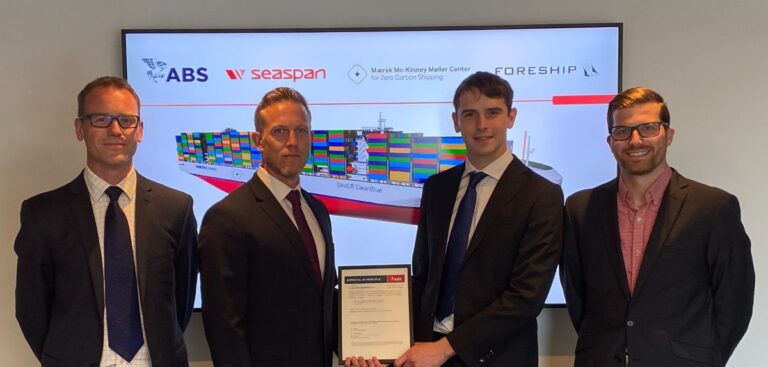The Seaspan Corporation and Mærsk Mc-Kinney Møller Center for Zero Carbon Shipping (MMMCZCS) have been awarded an Approval in Principle by the American Bureau of Shipping (ABS) for a 15,000 TEU, ammonia-fueled container vessel designed by Foreship.
In 2022, Seaspan and the MMMCZCS began a collaborative project to gain a better understanding of the challenges in designing a large ammonia-fueled container vessel. Working with vessel designer Foreship and classification society ABS, a design concept for a 15,000 TEU container vessel was developed.
The partners defined safety objectives and the impact that ammonia may have on the vessel’s performance, carried out a hazard identification qualitative risk assessment, and analyzed the fuel range and endurance, the ammonia tank and system location, electrical system design and vessel stability.
The project is connected to the Singapore Ammonia Bunkering Feasibility Study (SABRE), a consortium which aims to develop and demonstrate an ammonia supply chain in Singapore. Phase 1 of the project involved an end-to-end technical and commercial feasibility study of ammonia bunkering in Singapore, along with a preliminary ammonia bunkering vessel design. Phase 2 is investigating how to mature the commercial feasibility.
The vessel has been designed as a potential receiver of ammonia fuel from bunker vessels currently under design and development.
“This is a very good example of industry collaboration, where leading maritime organizations are working together and taking tangible steps to decarbonize the maritime industry,” said Peter Jackson, senior vice president Assets and Technology, Seaspan Corporation. “Ammonia is a very promising future marine fuel and this project is a vital and significant step in the development and realization of ammonia powered containerships.”
Thomas McKenney, head of ship design at Mærsk Mc-Kinney Møller Center for Zero Carbon Shipping, added, “This project highlights the importance of collaborative design development and proper safety case integration as the ammonia fuel pathway matures for the maritime industry.”
“This landmark vessel is an important step toward helping shipowners and operators benefit from ammonia’s zero-carbon tank-to-wake emissions profile,” commented Panos Koutsourakis, ABS vice president, Global Sustainability. “However, ABS recognizes that ammonia presents a specific set of safety and technology challenges, and we are committed to leading the industry in supporting its safe adoption at sea.”



